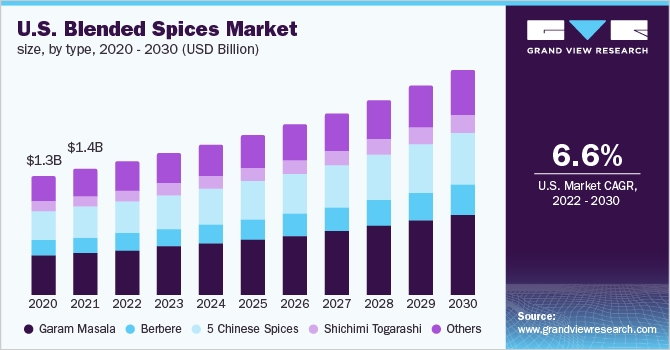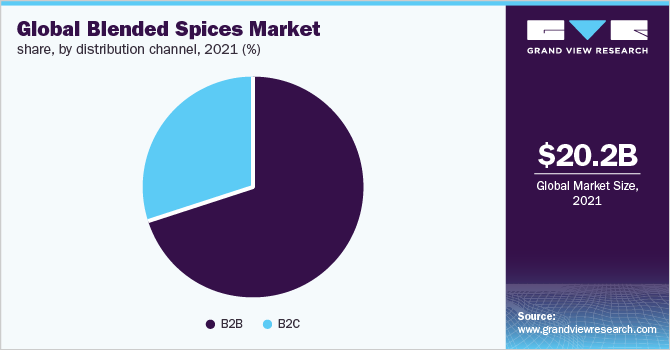
Blended Spices Market Size, Share & Trends Analysis Report By Type (Garam Masala, Berbere, 5 Chinese Spices, Shichimi Togarashi), By Distribution Channel (B2B, B2C), By Region, And Segment Forecasts, 2022 - 2030
- Report ID: GVR-4-68039-967-9
- Number of Report Pages: 80
- Format: PDF
- Historical Range: 2017 - 2020
- Forecast Period: 2022 - 2030
- Industry: Consumer Goods
Report Overview
The global blended spices market size was valued at USD 20.23 billion in 2021 and is expected to expand at a compound annual growth rate (CAGR) of 5.4% from 2022 to 2030. With the growing consumption of packaged foods, the usage of blended spices in exotic cuisines has augmented, thus boosting the growth of the market. Moreover, health consciousness among people has improved the total consumer base of blended spices, which is driving the market. The consumption of blended spices in excess proved to disturb one’s health negatively. Spicy food also leads to digestion-related problems. Thus, the ill effects of excess spice intake hinder the growth of the market in terms of value sales. The demand for some blended spices is high among consumers due to their health benefits, which provide ample opportunity for the market players.

The coronavirus pandemic has had a positive impact on the global market. The demand for blended spices has increased since the COVID-19 pandemic broke out. Spices thought to be immune boosters, like turmeric, ginger, and garlic, are in strong demand. Despite higher retail costs for these spices, purchasing did not decline. According to industry sources, the demand for turmeric as well as ginger for food supplements augmented by 300%.
Blended spices are a mix of several herbs and spices in precise quantities to give an aromatic flavor in regular cooking. Blended spices are manufactured using numerous plant parts such as flowers, barks, seeds, leaves, fruits, buds, and roots. Blended spices are a mix of two or more spices that are essential for the making of many complex recipes. Top brands such as Catch Spices, Everest Spices, and Ajinomoto India have set a mark in taking the Indian blended spices route to the international level. The global demand for such healthy blended spices shows the market’s upward trajectory.
According to the Spices Board of India, spice exports have been able to record a significant increase in both volume and value. The blended spices exports have recorded considerable growth in the last five years and India commands a forbidding position in the World Spice Trade. Because of globalization, people have discovered several flavors from all over the world, and they have become conscious of the nutritional benefits related to blended spices, which has augmented their consumption in the global market. Blended spices are in high demand in the market since they can readily produce a range of flavors.
Type Insights
The garam masala segment dominated the market with a revenue share of over 35.0%. Garam masala is a blend of popular ground spices such as cinnamon, peppercorns, cardamom, and mustard seeds. It is a spice blend largely used all over South Asia, especially in India, Pakistani, and Nepalese cuisines. It is one of the most famous spice blends in India. Garam masala has a deep, savory flavor with a rich brightness and peppery notes that warm the tongue. Garam masala comprises carminative qualities that support bloating, gas, and even nausea, in addition to enhancing digestion. Therefore, it is largely consumed all over the world.
The berbere segment is projected to expand at a considerable CAGR of 5.8% over the forecast period. The trend of eating ethnic food is increasing at a significant rate in North America as well as Europe, which is accredited to the growing multicultural population in these regions. As a subsequence, small and large-scale companies are entering into the ethnic food industry, thus driving the demand for berbere spices over the forecast period. Moreover, berbere spices being native to the Middle East and Africa region are expected to witness a remarkable rise in demand.
Distribution Channel Insights
In 2021, the B2B segment held the largest revenue share of over 65.0% and is likely to dominate the market over the forecast period. It is the shortest and simplest channel of direct distribution of products from the manufacturer to customers. B2B distribution permits brands to build genuine relationships with the consumers of their products. In addition, these fulfillment services give brands the opportunity to develop customer loyalty and trust by engaging with them. Most customers appreciate the opportunity to deal directly with the manufacturers of a product.

The B2C segment is estimated to register a significant CAGR of 5.1% over the forecast period. Convenience and speed are the main advantages of indirect distribution to the customer. B2C sales channels permit companies to enter new markets rapidly and easily, often at minimum initial risk and cost. In addition, most companies gain access to a large consumer base without the challenge of getting the customer through the door. B2C sales can be a giant accelerator for companies as it is tapping into a new customer base.
Regional Insights
Asia Pacific accounted for the largest revenue share of over 55.0% in 2021. The demand for blended spices is primarily driven by domestic consumption followed by eatery outlets. China has been able to claim a major part of the global market share owing to the enhanced color value. The aroma, color, flavor, and texture of the amazing varieties of blended spices in India nurture a rich variety of cuisines as well as cultures. India holds a prominent position in the world for blended spice manufacturing, providing over 2000 ranges of spices, such as a blend of whole, chopped, grounded, roasted, and seasoning spices. Moreover, various countries in the region such as Bangladesh, Thailand, and Indonesia largely consume blended spices.

North America is anticipated to expand at the fastest CAGR of 6.5% over the forecast period. Various major manufacturers introduced different blended spices, which have observed demand from many strata of the population as blended spices are useful across numerous applications including savory snacks and ready meals. Moreover, the inclination of consumers to buy healthier products offering convenience and variety in flavor is anticipated to drive the market in this region.
Key Companies & Market Share Insights
In order to stay competitive in the market, players are focusing on increasing the taste along with the quality of blended spices in order to attract health-conscious consumers. With a large number of ingredients in the masala recipe, players can retune the recipe products to maintain pricing without impacting taste.
-
In January 2021, McCormick completed the acquisition of FONA International, a producer of natural and clean flavors. This acquisition strengthens McCormick’s global growth strategy as FONA expands the breadth of the flavor solutions segment into attractive categories, extends its technology platform, and bolsters its abilities. Additionally, the acquisition would boost the strategic movement of the suite to more enriched and technically wrapped products and thus, is expected to be additive to profit
-
In April 2022, DPGC launched a range of new-age blended spices
Some prominent players in the global blended spices market include:
-
Spices, Inc.
-
Tony Chachere's
-
Empresas Tajín
-
Badia Spices, Inc.
-
Mahashian Di Hatti Private Limited
-
Shan Foods (Pvt.) Ltd.
-
McCormick & Company, Incorporated
-
Everest Food Products Pvt. Ltd.
-
World of Spice Ltd.
-
MTR Foods Pvt Ltd.
Blended Spices Market Report Scope
|
Report Attribute |
Details |
|
Market size value in 2022 |
USD 21.16 billion |
|
Revenue forecast in 2030 |
USD 32.58 billion |
|
Growth rate |
CAGR of 5.4% from 2022 to 2030 |
|
Base year for estimation |
2021 |
|
Historical data |
2017 - 2020 |
|
Forecast period |
2022 - 2030 |
|
Quantitative units |
Revenue in USD million/billion and CAGR from 2022 to 2030 |
|
Report coverage |
Revenue forecast, company ranking, competitive landscape, growth factors, and trends |
|
Segments covered |
Type, distribution channel, region |
|
Regional scope |
North America; Europe; Asia Pacific; Central & South America; Middle East & Africa |
|
Country scope |
U.S.; Canada; Mexico; U.K.; Germany; France; Italy; China; Bangladesh; India; Indonesia; Thailand; Brazil; UAE; Saudi Arabia |
|
Key companies profiled |
Spices, Inc.; Tony Chachere's; Empresas Tajín; Badia Spices, Inc.; Mahashian Di Hatti Private Limited; Shan Foods (Pvt.) Ltd.; McCormick & Company, Incorporated; Everest Food Products Pvt Ltd.; World of Spice Ltd.; MTR Foods Pvt. Ltd. |
|
Customization scope |
Free report customization (equivalent up to 8 analysts working days) with purchase. Addition or alteration to country, regional & segment scope. |
|
Pricing and purchase options |
Avail customized purchase options to meet your exact research needs. Explore purchase options |
Global Blended Spices Market Segmentation
This report forecasts revenue growth at the global, regional, and country levels and provides an analysis of the latest industry trends and opportunities in each of the sub-segments from 2017 to 2030. For the purpose of this study, Grand View Research has segmented the global blended spices market report on the basis of type, distribution channel, and region:

-
Type Outlook (Revenue, USD Million, 2017 - 2030)
-
Garam Masala
-
Berbere
-
5 Chinese Spices
-
Shichimi Togarashi
-
Others
-
-
Distribution Channel Outlook (Revenue, USD Million, 2017 - 2030)
-
B2B
-
B2C
-
-
Regional Outlook (Revenue, USD Million, 2017 - 2030)
-
North America
-
U.S.
-
Canada
-
Mexico
-
-
Europe
-
U.K.
-
Germany
-
France
-
Italy
-
-
Asia Pacific
-
China
-
Bangladesh
-
India
-
Indonesia
-
Thailand
-
-
Central & South America
-
Brazil
-
-
Middle East & Africa
-
UAE
-
Saudi Arabia
-
-
Frequently Asked Questions About This Report
b. The global blended spices market size was estimated at USD 20.23 billion in 2021 and is expected to reach USD 21.16 billion in 2022.
b. The global blended spices market is expected to grow at a compound annual growth rate of 5.4% from 2022 to 2030 to reach USD 32.58 billion by 2030.
b. Garam masala dominated the blended spices market with a share of 35.2% in 2021. This is attributable as garam masala has a deep, savory flavor with a rich brightness and peppery notes that warm the tongue, and comprises carminative qualities that support bloating, gas, and even nausea, in addition to enhancing digestion.
b. Some key players operating in the blended spices market include Spices, Inc.; Tony Chachere's; Empresas Tajín; Badia Spices, Inc.; Mahashian Di Hatti Private Limited; Shan Foods (Pvt.) Ltd; McCormick & Company, Incorporated; Everest Food Products Pvt Ltd; World of Spice Ltd.; and MTR Foods Pvt Ltd.
b. Key factors that are driving the blended spices market growth include the growing consumption of packaged foods, the usage of blended spices in exotic cuisines, and health consciousness among people has improved the total consumer base of blended spices.
We are committed towards customer satisfaction, and quality service.
"The quality of research they have done for us has been excellent."




